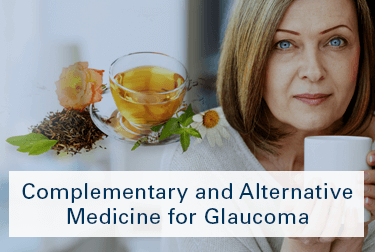A collection of eye disorders known as glaucoma, sometimes called the "silent thief of sight," harms the optic nerve and causes progressive, permanent vision loss. Glaucoma is a serious health concern as it is one of the primary causes of blindness globally. Although traditional glaucoma therapies like medication, laser therapy, and surgery are essential, complementary and alternative medicine (CAM) methods are becoming more and more popular as a way to enhance traditional treatments and enhance general eye health.
Understanding Glaucoma:
Over time, rising intraocular pressure (IOP) can cause damage to the optic nerve in cases of Glaucoma, a complex eye condition. Until the damage is severe enough to cause observable symptoms, such as peripheral vision loss, it frequently happens without any symptoms. Preventing irreversible visual deterioration hence requires early detection and treatment.
Conventional Treatment Options:
To slow down or stop the evolution of the illness, the main goal of current conventional treatments for glaucoma is to lower intraocular pressure. Eye drops, oral drugs, laser trabeculoplasty, and surgical procedures like shunt implantation or trabeculectomy are some of these treatments. Although many patients find success with these procedures, there is a need for complementary approaches because of the potential negative effects and limits of these approaches.
Examining Complementary and Alternative Medicine (CAM):
CAM refers to a wide range of treatments, procedures, and goods that are not included in traditional medical practices. Although CAM shouldn't take the place of traditional glaucoma therapies, it can be a useful addition to support general eye health and well-being. The following are CAM techniques that glaucoma sufferers may want to think about
Nutritional Supplements:
Research has examined the possible advantages of several vitamins minerals, and antioxidants in maintaining eye health and lowering the risk of glaucoma progression. These include elements in leafy green vegetables such as lutein and zeaxanthin and vitamins C, E, zinc, selenium, and omega-3 fatty acids.
Acupuncture:
Acupuncture is a traditional Chinese medicine technique that involves inserting tiny needles into predetermined body sites. It has been investigated as an adjunctive glaucoma treatment. Although there is little data to support the effectiveness of acupuncture in treating glaucoma, some studies indicate that it may help lower intraocular pressure and enhance ocular blood flow.
Herbal Medicine:
Research has been done on the possible therapeutic benefits of a few herbs and botanical preparations for glaucoma. For instance, the well-known herbal supplement ginkgo biloba is said to enhance blood circulation and may have neuroprotective qualities that may help glaucoma sufferers. More investigation is needed to determine its safety and effectiveness in the treatment of glaucoma, though.
bimatoprost eye drop :
The main purpose of bimatoprost eye drops is to treat glaucoma, a condition in which elevated intraocular pressure damages the optic nerve but never results in visual loss. Another effective treatment for ocular hypertension is this eyedrop. a situation in which the eye's internal pressure is elevated but does not harm the optic nerve or cause vision loss.
Mind-Body Approaches:
Mindfulness-based stress reduction (MBSR), yoga, and meditation are some examples of stress-reduction strategies that can assist people with glaucoma manage the psychological and emotional effects of their illness. These techniques may tangentially lead to better outcomes for eye health by encouraging relaxation and enhancing general well-being.
Conventional Treatments:
Conventional medical systems, such as Ayurveda and traditional Chinese medicine, provide a comprehensive approach to health and wellness, which includes methods for preserving eye health. Within these systems, recommendations may be made for practices like eye exercises, herbal formulations, and lifestyle changes to support general eye health and reduce glaucoma symptoms.
People with glaucoma can investigate a wide range of complementary and alternative medicine (CAM) strategies to improve their general eye health and quality of life. Although complementary and alternative medicine (CAM) methods should be used sparingly and in concert with traditional treatments, they can enhance current therapies and advance overall well-being. To ensure safety and effectiveness in managing their disease, people with glaucoma should speak with their healthcare providers before introducing complementary and alternative medicine (CAM) into their treatment regimen. People with glaucoma can empower themselves to actively participate in maintaining their eyesight and enhancing their eye health for years to come by adopting a holistic strategy that incorporates both conventional and unconventional therapies.


